oracle 1z0-900 practice test
Java EE 7 Application Developer Exam
Last exam update: Jul 20 ,2024
Question 1
You want to allow one set of roles to POST to a resource and another set of roles to GET it.
Which two configuration options should you use? (Choose two.)
- A. two separate @HttpMethodConstraints annotations and sets of roles
- B. a single @HttpMethodContstraint annotation and a map of method to roles
- C. two <web-resource-collection> with different <http-method> in the deployment descriptor
- D. a single <web-resource-collection> with two <auth-constraint> with different <http-method> in the deployment descriptor
Answer:
B,D
Question 2
Given the code fragment: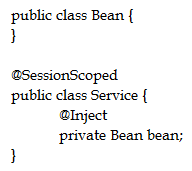
Assuming this bean is used only in the code fragment above, how long will the injected Bean
instance be available?
- A. for the lifetime of the enterprise application
- B. for the lifetime of the request
- C. for the lifetime of the session
- D. for the lifetime of the Service object
Answer:
D
Question 3
Which is a valid description of REST?
- A. REST provides the same architectural properties as SOAP.
- B. REST is a library that is part of JEE called JAX-RS.
- C. REST is the conventional way of interacting with information resources.
- D. REST is a Web Services standard supported by JEE and JAX-RS.
Answer:
D
Explanation:
Reference:
https://docs.oracle.com/javaee/6/tutorial/doc/giepu.html
Question 4
Given: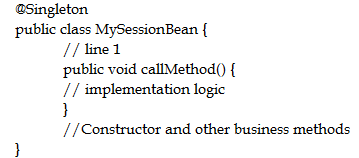
Which annotation do you use on line 1 to ensure that clients immediately time out when attempting
to concurrently invoke callMethod () while another client is already accessing the bean?
- A. @AccessTimeout (value = 1, unit = TimeUnit.SECONDS)
- B. @AccessTimeout (null)
- C. @AccessTimeout (-1)
- D. @AccessTimeout (0)
Answer:
D
Explanation:
Reference:
http://tomee.apache.org/examples-trunk/access-timeout/
Question 5
Which statement is true about the relationship between HTTP and WebSockets?
- A. A WebSocket connection is a bi-directional HTTP session with message-handling support.
- B. A WebSocket connection is initialized with an HTTP handshake.
- C. A WebSocket connection can be initialized by either client or server.
- D. A WebSocket connection uses HTTP protocol to exchange data with the browser.
Answer:
D
Question 6
A Java EE application that uses an EJB container must communicate with a legacy system developed
using non-Java technologies.
Which two Java EE technologies can be used in the integration tier of the application? (Choose two.)
- A. JMS
- B. JSF
- C. JPA
- D. JCA
Answer:
A,B
Question 7
Which code snippet indicates that the page you are designing is capable of handling errors?
- A. <%@page errorPage=“errorHandler.jsp”%>
- B. <%= requestScope[‘javax.servlet.error’] !=null %>
- C. <%@page isErrorPage=“true”%>
- D. <c:set var=“errorHandler” value=“true”/>
Answer:
C
Question 8
Which two elements CANNOT be injected by using an @Inject annotation? (Choose two.)
- A. static fields
- B. instance fields declared final
- C. concrete methods
- D. abstract methods
Answer:
B,D
Explanation:
Reference:
https://docs.oracle.com/javaee/6/api/javax/inject/Inject.html
Question 9
Given the following code: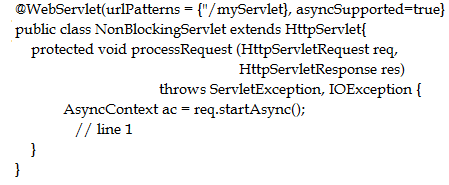
What should you do at line 1 to enable this servlet receive request data without blocking?
- A. Use a Runnable instance with the start () method of AsyncContext.
- B. Define a ReadListener and assign it to the request input stream.
- C. Create a Callable class and delegate this operation to a ManagedExecutorService by using the dispatch method of AsyncContext.
- D. Define an AsyncListener and assign it to the AsyncContext object.
Answer:
D
Question 10
Identify two valid WebSocket message types for which you can register handlers. (Choose two.)
- A. Error Message
- B. Binary Message
- C. Pong Message
- D. Ping Message
Answer:
B,C
Explanation:
Reference:
https://docs.oracle.com/javaee/7/api/javax/websocket/Session.html
Question 11
You have been assigned to the Widget Editor portion of an application. It contains a Widget Editor
Facelet page, the Widget class, and a simple WidgetEditor backing bean, which contains a reference
to the current Widget instance.
Given the code fragment from the Widget class: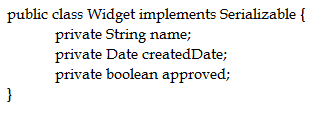
Given the code fragment from the Facelet page: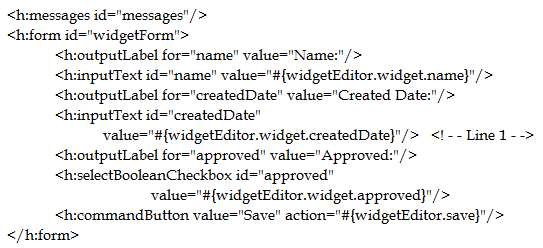
The page displays Conversion Error when a user fills out all the form fields and clicks the Save button.
Which step do you perform to fix this problem?
- A. Replace Line 1 with:<h: inputText id=createDatevalue=#{widgetEditor.widget.createdDate}converter=java.util.Date/>
- B. Enclose the code fragment within the <f:view/> tag
- C. Insert <f:convertDateTime”/> at Line 1
- D. Replace Line 1 with:<h:inputText id=createDatevalue=#{widgetEditor.widget.createdDate}><f:convertDateTime pattern=dd-mm- yyyy/></h:inputText>
Answer:
D
Question 12
You created two filters for your web application by using the @WebFilter annotation, one for
authorization and the other for narrowing results by the provided search criteria. The authorization
filter must be invoked first.
How can you specify this?
- A. setting the priority attribute of the @WebFilter annotation for each of the filters
- B. placing the filter mapping elements in the required order in the web.xml deployment descriptor
- C. placing @WebFilterMapping annotations in the required order
- D. specifying the filter precedence order by using the @Priority annotation
Answer:
A
Question 13
Which of these can be a JPA entity?
- A. Enum type
- B. Abstract class
- C. Interface type
- D. Final class
Answer:
A
Question 14
Which two features are provided by the JSTL Core library for a JSP? (Choose two.)
- A. iteration over a collection
- B. buffering of large result sets
- C. testing conditions
- D. message localization
Answer:
A,D
Explanation:
Reference:
https://www.journaldev.com/2090/jstl-tutorial-jstl-tags-example
Question 15
How can a servlet indicate to the browser that cookie data should be sent over a secure connection?
- A. Call the getSecure(true) method on the cookie object.
- B. Encrypt the cookie data. The browser automatically sends encrypted data over a secure connection.
- C. Set the ENCRYPT header in the response.
- D. Configure SessionTrackingMode.SSL on the ServletContext object.
Answer:
A
Explanation:
Reference:
https://docs.oracle.com/javaee/6/api/?javax/servlet/http/Cookie.html